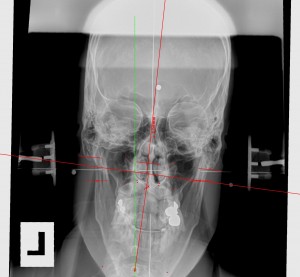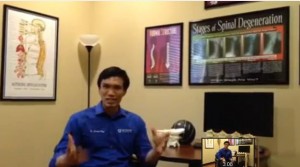Ask the Docs

Don’t Crack Your Own Neck Before Reading This
A wave of videos and books teach you to adjust or manipulate yourself. Will you get hooked on the crack? Is it safe?
By Dr. Jonathon Chung of Keystone Chiropractic
I’m sure you see it almost everyday. Whether it’s the local weight lifter before he hops on a bench, the fidgety co-worker who likes to hear all of his joints pop, or the guy on the plane that’s been rubbing his neck all day.
It’s the serial neck popper. They look straight out of the warm up scene of a martial arts movie, sound effects and all. While most will cringe and bite their tongue when they see it, the serial neck popper looks more focused and at ease. In fact, if their joints were capble of it, these people might pop it more often. Heck, it might even be you.
“It feels so good, how bad can it be?”
Some of the people who come into my office for care used to be serial neck poppers. Emphasis on the words “used to be”. One of my first recommendations for people when they get their first adjustment is to avoid popping or cracking their neck. There’s usually a look of defeat on their face when I give them that recommendation. But the truth is that one of their greatest sources of relief from neck discomfort was actually the very thing that was making their problem a chronic issue.
http://chiropractorwellington.com/wp-content/uploads/2014/04/bad-nasium.jpghttp://chiropractorwellington.com/wp-content/uploads/2014/04/bad-nasium.jpg
The loose ligaments, and uncontrolled forces from self-manipulation prevent this neck from staying in place.
The x-ray on the right is an example of someone who spends a lot of time popping their own neck. He had no history of a car accident, sports injury, fall, or trauma. However, he has been popping his neck aka, self-manipulating multiple times per day for years.
The green line represents the center point where a person’s head and neck should line up. The red line represents how the patient’s head and neck currently line up in their “normal” seated position.
should line up. The red line represents how the patient’s head and neck currently line up in their “normal” seated position.
The level of displacement is not hard to see. In fact, most of you would probably notice someone like this who always holds their neck off to the side.
Though he always feels his neck is very tight, the neck tends to be very floppy without a strong degree of stability. Even after several corrections, his neck will continue to have a tendency to slip towards the side until the ligaments tighten up and heal.
What Happens?
So what exactly happens when you self-manipulate?
Despite popular belief, there is nothing insidious about the popping sound made by joints. The classic crunching sound that you hear, and is stereotyped with chiropractic has nothing to do with broken bones, or rubbing bones against each other. The sound comes from tiny gas bubbles within the fluid that lubricates your joints. When the joint opens up rapidly, these bubbles get released and pop causing those sounds.
It’s more like opening a can of soda than the crunching of a bone. If your neck or back cracks here and there with normal movement, it’s not a cause for concern most of the time.
The sound is ultimately not the problem. What truly is a problem is the way the thrust affects the spine.
In recent years, there have been videos, articles, and books that teach people how to adjust themselves. Now bear in mind, the neck is one of the most sensitive and important pieces of anatomy in the human body. So people are being taught to manipulate their neck without regard for the following factors:
1. Risk factors – Does your neck have disc bulges or protrusions? Are there plaques or anatomical malformations? Some of these risk factors are susceptible to rotation/twisting forces in the neck. Many of these problems can be identified and planned for with a proper examination, but without one, how do you know?
2. What is the current structure of the spine? – How is the spine currently aligned? Do you know which direction puts you into a better position? Are you moving the right vertebra? Are you pushing the vertebra into a worse position than it already is?
In my office, we use very precise, laser aligned x-rays to identify these malpositions in millimeters. Can your own hands do the same?
3. Constant Manipulation = Loose ligaments = Poor Stability – Every time you manipulate your spine, you are causing ligaments in the spine to stretch like a rubber band. When you stretch a rubber band enough times, it eventually loses it’s shape and becomes less stable. Your ligaments work the same way. If you keep pounding on your neck with self-manipulation, your neck eventually becomes a sloppy mess like the x-ray above.
When people have ligament instability, it leads them down the road where they depend on manipulation to keep feeling good. Not a good situation, and a big reason chiropractors get a bad rap for getting people “addicted to adjustments”.
So what now?
When choosing a chiropractor, it’s important that they are actually measuring what they are doing to the spine. Almost any chiropractor is able to make someone feel better with manipulation. Manipulation sends a rush of feel good signals into the brain. However, a Structural Chiropractic approach is more than about feeling better in the moment.
It’s about restoring your spine and your nervous system to a state of Normal. A normally functioning spine has the ability to heal and maintain itself without relying on constant manipulation.
That’s why the procedures we perform in our office Atlas Corrections. Because it’s truly about fixing the problem and getting it to stay fixed. Many times, these corrections can be performed without any rotation or twisting of the spine. It’s very gentle, and very effective.
Self-manipulation, while a temporary rush and feel good sensation can create hypermobility and long term structural problems in the neck. Additionally, it’s easy to become addicted to that feeling, and make your body dependent on constant manipulation to feel normal. In our world, we call that getting “hooked on the crack”. There are just too many questions about what can happen when you self-manipulate. It just doesn’t make sense to do something likely harmful for a few minutes of temporary relief.
Did you like this article? Feel free to share it with the people you care about and see if a Complimentary Consultation is the next step to regain their health.
***
Dr. Chung is a practicing Structural Chiropractor in the West Palm Beach area. He has been published in peer reviewed scientific journals and is a sought after speaker in health and wellness. Follow his blog at http://chiropractorwellington.com/category/keystone-chiropractic-blog/ or find him on twitter at @drjonathanchung.




